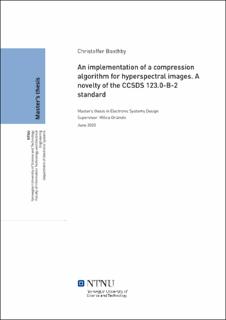| dc.contributor.advisor | Milica Orlandic | |
| dc.contributor.author | Christoffer Boothby | |
| dc.date.accessioned | 2021-09-15T16:59:18Z | |
| dc.date.available | 2021-09-15T16:59:18Z | |
| dc.date.issued | 2020 | |
| dc.identifier | no.ntnu:inspera:54579301:34103830 | |
| dc.identifier.uri | https://hdl.handle.net/11250/2778129 | |
| dc.description.abstract | I romindustrien har hyperspektrale kameraer vært kritisk for observasjoner av jorda for romforskining og industriell bruk. Bruken av hyperspektrale kameraer gir forskere muligheten å analysere det elektromagnetiske spekteret istedenfor å bruke vanlige farge kamera. Hyperspektrale kameraer gir muligheten for å observere for eksempel algevekst eller oljesøl. Disse problemene ga motivasjon for å danne prosjektet Hyperspectral Smallsat for Ocean Observation hos Norges teknisk-naturvitenskapelige universitet (NTNU) med formål å lage en satelitt og sende den til verdensrommet. Satelitten i en form av en cubesat vil observere jorden ved bruk av et hyperspektral kamera. Et problem ved å bruke cubesat er begrensningene på antennen for å overføre data til jorden. Dette gir motivasjon til å implementere en komprimerings algoritme av hyperspektrale bilder. Denne masteroppgaven vil implementere 2 standarder laget av Consultative Committee for Space Data Systems for komprimering av hyperspektrale bilder. Den første standarden CCSDS 123.0-B-1 er publisert i 2015 for tapsfri komprimering av hyperspektrale bilder. I prosjektet er denne standarden allerede implementert i form av en FPGA løsning og krevde derfor en implementasjon i programmeringspråket C som en sikkerhet.
Den andre standarden CCSDS 123.0-B-2 som er nylig publisert i 2019 gir en mulighet for komprimering med tap av kvalitet. Tap av kvalitet kan gi bedre komprimeringsrater i forhold til tapsfri komprimering. I tilegg gir standarden en mulighet til å kontrollere graden av kvalitetestap for bedre kompresjonsrater. Denne masteroppgaven vil fokusere på en implementasjon av CCSDS 123.0-B-2 i programmeringsspråket C. I tilegg vil oppgaven gå dypere i de mulige kompresjonsratene og bildekvaliteten som medfører av standarden. Det esulteres i en kompresjonsrate på 2-3 ved bruk av tapsfri komprimering. Ved å øke tapet av bildekvalitet vil kompresjonsraten gå vel over 100 når det brukes den nye "hybrid encoder". I forhold til den gamle bruken av "sample adaptive encoder" som når maksimalt en kompresjonsrate på 14-16. Kvaliteten av bildene går derimot ned fra det orginale bildet til en Peak signal-to-noise ratio (PSNR) som vil typisk være fra 90 til 20. Dette varierer av hvor hvilken grad komprimerings tapet er valgt, og hvilket bilde som er brukt. Implementasjonen av standarden krever videre arbeid og verifisering for å kunne fastslå en korrekt komprimerings algoritme. Siden introduksjonen av å kontrollere kvalitetstapet gjør det vanskelig for verfisering om resultatene er korrekte. | |
| dc.description.abstract | For many years in the space industry the usage of hyperspectral imaging has been used to observe the Earth for research and industrial uses. The usage of hyperspectral imaging allows researchers to analayze the wide spectrum of wavelengths instead of regular colors. In particular the possibility to observe algae blooms or oil spills with an hyperspectral camera. These issues gave birth to the mission Hyperspectral Smallsat for Ocean Observation at Norwegian University of Science and Technology which is to launch a cubesat into space to observe the earth using a hyperspectral camera. Due to the limited speeds of the transmission antenna on the cubesat introduces the requirement of image compression algorithms to reduce the demand on the antenna. This thesis will implement two standards developed by ConsultativeCommittee for Space Data Systems for compression of hyperspectral images. The first standard CCSDS 123.0-B-1 published in 2015 provides a method for lossless compression. The standard is already implemented as a FPGA solution in the on-board processing unit and required a software backup solution in the programming langauge C. The second standard CCSDS 123.0-B-2 recently published in 2019 is a new near-lossless compression algorithm of hyperspectral imaging. This thesis will focus on a software implementation of CCSDS 123.0-B-2 in the programming language C and further research the possible compression rates and image quality from this standard. With the possibility to control the amount of near-lossless in the compression algorithm allows a user to select the required quality of an image. The results from the implementation presents the possibility to achieve compression rates by using a lossless method. Achieving a typically compression rate of 2-3 when using the lossless method. By increasing the near-lossless the compression rates increases to beyond 100 when using the new hybrid encoder. A comparison with the sample adaptive encoder is presented and it peaks typically at a compression rate of 14-16. This does however come at the cost of image quality where the Peak signal-to-noise ratio (PSNR) ranges from 90 to 20 depending of the level of near-lossless, and the type of image. The implementation still requires some future work and verification to determine a functioning compression algorithm as the introduction of near-lossless creates a difficult problem of testing. | |
| dc.language | eng | |
| dc.publisher | NTNU | |
| dc.title | Implementasjon av en komprimerings algoritme for hyperspektrale bilder. En innovasjon av CCSDS 123.0-B-2 standarden. | |
| dc.type | Master thesis | |
